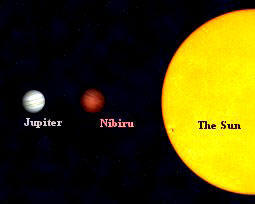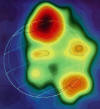|
January 2001
It will be clear to anyone reading the papers by Drs Murray and Matese that the trajectory described by the giant planet in the Oort cloud was roughly circular, and at a great distance from the Sun (1, 2).
When corresponding by e-mail with both of these astronomers, they have made it plain to me that this is a major stumbling block to equating the body each of them describe, to that described by Sitchin (3, 4).
There is little necessity for either of them to explore these issues, and so that's where the matter ends for them. But I think I have shown sufficient correlation between Nibiru and their giant planets, particularly as described by Dr. Murray, to attempt to find an explanation for this discrepancy.
I think I have found that reason, and the
evidence for it comes from one of the central supporting academic papers
cited by
Matese. Data from this paper is fundamental to our understanding of
what might have happened between the perturbation of the comets millions of
years ago, that were used to describe the giant planet's orbit, and its
present eccentric orbit.
It is unusual for me
to concentrate particularly on one paper in this way, but I suspect the
reader will soon discover why I have done so.
This body was known
as ‘Nemesis’, a black dwarf star or low-mass star at 90,000 AU. It remains
hypothetical, and would certainly be a far more massive body than the one we
are considering in this book.
Hills ran computer simulations at the Los Alamos National Laboratory of a 3 body system, consisting of a Sun and Jupiter-like Planet couple, which became subject to interaction with a massive body, either entering from interstellar space, or perturbed from a quiet corner of the Sun’s comet clouds (5).
His findings are highly relevant to our debate, centering as they do on the scenario described by Sitchin.
At that time, Sitchin's analysis of Nibiru was for a much smaller body than a brown dwarf.
However, it seems highly likely that Nibiru is indeed a failed star, not a planet in the conventional sense, and we should now look at Hills’ findings in this new light.
One of the first points Hills raises is that a body, at the sort of distances proposed for Nemesis, is liable to be perturbed into an orbit that brings it through the planetary solar system, by the action of passing stars.
(ROSAT Soft X-ray HRI Image Of Jupiter: This image (right) of Jupiter was taken by ROSAT during the impact of comet Shoemaker-Levy 9 in July, 1994
See below REPORT:
His mathematical modeling shows that this potential effect is most likely to happen if the massive body lies at 20,000AU, (a distance close to Matese’s estimate of 20,000AU for his massive planet):
Matese then discussed 'oscultations' of such an orbit, but it is clear from Hill's paper that he has something more drastic in mind. As Hills says, "objects in the Oort cloud are severely perturbed by passing stars". We cannot assume, therefore, that the findings of Murray and Matese, derived from the beginnings of cometary journeys millions of years ago, continue to describe the orbit of the massive body up to the present day.
Not only that, but the evidence from the comets’ movements is a fragmented picture. It indicates a trend that points to the presence of this massive body, but it does not present us with a cast-iron blue-print for the body’s current position.
If it had, we would already have detected it, surely? There are
approximations involved here, and a relatively recent perturbation of Nibiru’s orbit would not lie outside the criteria for meeting the data these
two researchers have worked with. It might also explain why it has defied
detection since these papers came out in 1999, despite the other brown dwarf
discoveries.
Yet Hills shows us that the orbits they describe for the massive body are unstable, and subject to radical change when affected by a passing star. It seems to me that this might have occurred when the Sun passed by Sirius several million years ago, that the massive gravity of the Type A star Sirius A was sufficient to drag Nibiru into the planetary system, and change its orbit to a highly elongated ellipse.
If not the Sirius system, then gigantic molecular clouds in Orion
(6).
The circular orbits described by Murray and Matese are unstable and subject to perturbation, just like the comets. In case this might seem too incredible, I would like to explore the results of Hills’ computer simulations in some depth.
This may be somewhat of a dry discussion, but bear with me:
This provides an upper limit on the size of such a body, ruling out Nemesis, a presumed black dwarf at the farthest reaches of the solar system, as an interloper.
Other sections of the paper place a limit of 10 Jupiter masses on an intruder from the Oort cloud, but this still remains consistent with the brown dwarf finding: The body described by Murray and Matese is a ‘planet’, or brown dwarf , of only a few Jupiter masses. Such a body will not radically alter the general circularity of the orbits of the solar planets, unless a collision is involved.
This is of fundamental importance,
because it shows that a brown dwarf could pass within the planetary orbits
without unduly affecting them.
This just so happens to be the ‘place of the crossing’ of Nibiru as described by the Sumerian texts! Having eliminated the possible movement of Nemesis through our system, did Hills systematically turn his attention to Sitchin’s work, and find a correlation?
This appears to be the unspoken message. Of course, Hills might have chosen the radius of the Jupiter like planet to simplify his calculations, but this seems an arbitrary point. Either way, the coincidence helps us to understand how Nibiru's orbit came into being.
As Hills notes:
As Jupiter lies at approximately 5AU distance, the new orbital semi-major axis of Nibiru could approximate to 350 times that, or about 2000AU.
Conclusion 3
Nibiru's current aphelion position could be as distant as 2000AU.
So Nibiru, if it had been disturbed from its circular orbit in the Oort cloud, might now have an aphelion distance of less than 10% of the values determined by Murray and Matese. That the distance is an order of magnitude less allows Nibiru to traverse a highly elongated elliptical orbit in about 3600 years, without being ejected from the solar system.
This was another
major stumbling block as far as Dr Murray was concerned
(3).
The one described by the Sumerians. Impossible? Hills doesn’t seem to think so. Do I have evidence for this?
Yes, I think I do, in that the change of Nibiru’s orbit, returning it to the planetary system after many, many millions of years caused our climate to change. The evidence is in our geological records, and involves the puzzling advent of long-period ice-ages. Again, the basis of this conclusion lies in this ground-breaking paper by Hills, and I shall explore this idea in depth in a subsequent posting.
This has to do with the 'binding energies' of the planets, and how their orbital radii are affected by the new orbit attained by the interloper.
I suspect that this simbiotic relation between the
Earth
and Nibiru is what the Sumerians meant by the
'Bond Heaven-Earth', and why
the ancient world put such store on an accurate calculation of the calendar.
The Earth's orbit and environment were affected by the new
eccentric orbit through a dynamic interplay of planetary 'binding energies',
and our geological record itself indicates the return of Nibiru from the
Oort Cloud
Nibiru will again return to the outer Oort cloud, and this model might show that Nibiru has had an oscillating orbit for as long as it has been in our solar system. This is what is meant by the term 'oscultation', as used by Matese. Hills simply shows how an highly eccentric orbit for the Oort cloud object could be derived from such an orbital change.
I suspect that these 'oscultations' then account for the
long period Ice Ages, occurring when Nibiru is perturbed into a temporary
eccentric, elliptical orbit that brings it into the planetary solar system.
When it is describing a slow circular orbit, we have a warmer climate, often
for hundreds of millions of years.
As Nibiru's orbit lengthens, and it begins its gradual return to a slow,
circular orbit in the Oort cloud, our orbit gains binding energy, our
orbital radius contracts, and our climate warms.
Nibiru's orbit is currently lengthening, and our climate is subsequently warming once again.
This change might also indicate why the
Anunnaki have left our world now. As
Nibiru's orbit has decayed, their chances of seeing Nibiru move within the
orbit of Jupiter during the next perihelion passage decrease. They might not
want to lose the chance to get back home again!
I suspect that the same celestial event that brought about the Flood 13-14,000 years ago altered Nibiru's unstable 'temporary' orbit sufficiently to again change the bond between the Sun and Nibiru. This might have been a close passage by Jupiter, for instance, perturbing the elliptical orbit, and creating a sufficiently large disruption to the Sun-Jupiter magnetosphere interaction to bring about the Earth-changes involved.
I will be exploring this in depth
later.
The argument goes that the gravitational effect of such massive bodies in the planetary system would cause the other planets to become unstable and begin careering around.
A discovery by Marcy’s team regarding a star system some 123 light years away has brought that into question. The system, poetically named HD168443, contains a giant planet that is 17 times the mass of Jupiter. Normally, the astronomers would classify this is a brown dwarf, but this body’s close proximity to its star has brought that assumption into question (8).
To be circling the star in the relatively close orbit involved, the body should have formed by gas accretion, yet is far more massive than this model should allow:
To complicate matters still further, another massive planet, this time 7 times as massive as Jupiter, enjoys a circular orbit within the orbit of the first.
Yet the overall system is described as ‘extremely stable’.
This system will send many astronomers back to the drawing board in an effort to figure out how these planets formed and how they enjoy such stable orbits as close as they are to their host star. This example serves to proves that gargantuan planets such as these, that defy classification, can surprise astronomers. Similarly, a massive planet in orbit around our Sun need not have the detrimental effect on the rest of the system that many would provisionally assume.
This recent finding seems to bear Hills out.
Notes
|



 A brown dwarf of less than 10 Jupiter masses could have
regularly passed through the planetary solar system, and the known planets
would still appear as they do today.
A brown dwarf of less than 10 Jupiter masses could have
regularly passed through the planetary solar system, and the known planets
would still appear as they do today.